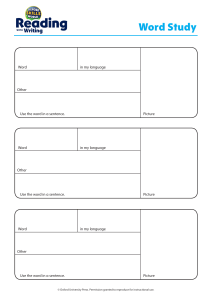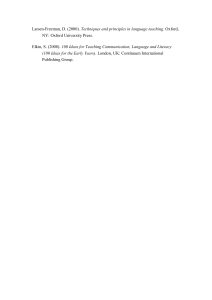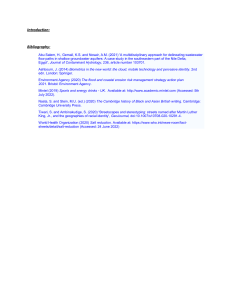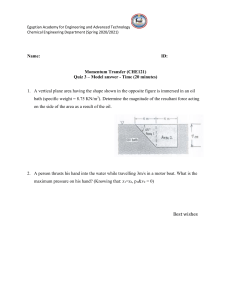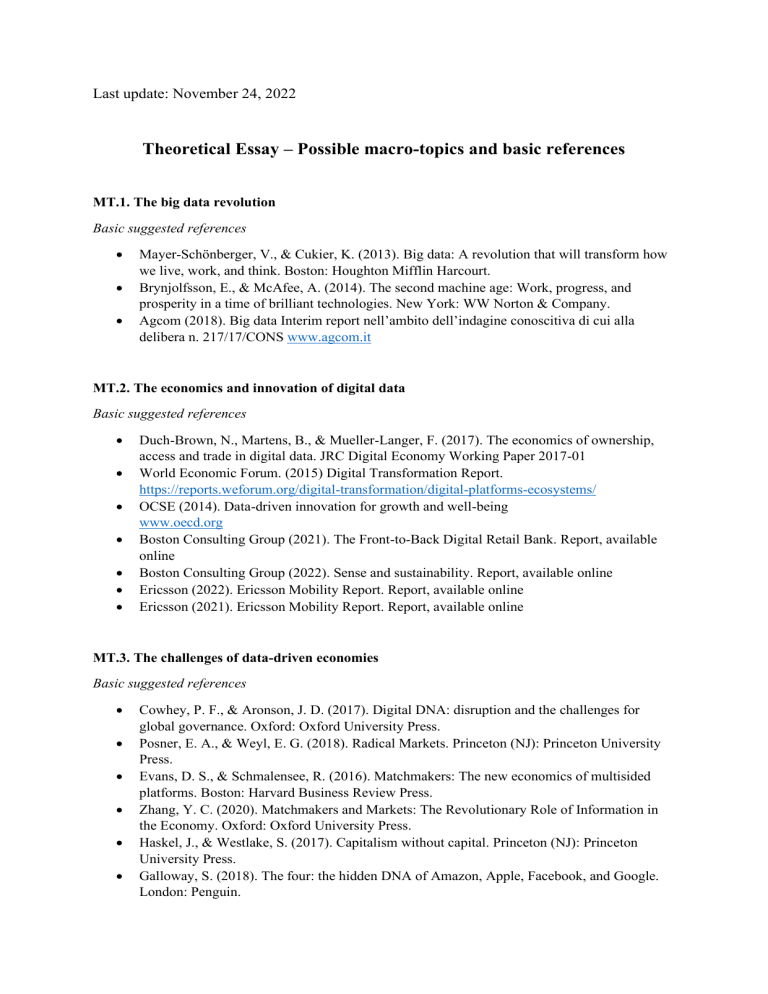
Last update: November 24, 2022 Theoretical Essay – Possible macro-topics and basic references MT.1. The big data revolution Basic suggested references • • • Mayer-Schönberger, V., & Cukier, K. (2013). Big data: A revolution that will transform how we live, work, and think. Boston: Houghton Mifflin Harcourt. Brynjolfsson, E., & McAfee, A. (2014). The second machine age: Work, progress, and prosperity in a time of brilliant technologies. New York: WW Norton & Company. Agcom (2018). Big data Interim report nell’ambito dell’indagine conoscitiva di cui alla delibera n. 217/17/CONS www.agcom.it MT.2. The economics and innovation of digital data Basic suggested references • • • • • • • Duch-Brown, N., Martens, B., & Mueller-Langer, F. (2017). The economics of ownership, access and trade in digital data. JRC Digital Economy Working Paper 2017-01 World Economic Forum. (2015) Digital Transformation Report. https://reports.weforum.org/digital-transformation/digital-platforms-ecosystems/ OCSE (2014). Data-driven innovation for growth and well-being www.oecd.org Boston Consulting Group (2021). The Front-to-Back Digital Retail Bank. Report, available online Boston Consulting Group (2022). Sense and sustainability. Report, available online Ericsson (2022). Ericsson Mobility Report. Report, available online Ericsson (2021). Ericsson Mobility Report. Report, available online MT.3. The challenges of data-driven economies Basic suggested references • • • • • • Cowhey, P. F., & Aronson, J. D. (2017). Digital DNA: disruption and the challenges for global governance. Oxford: Oxford University Press. Posner, E. A., & Weyl, E. G. (2018). Radical Markets. Princeton (NJ): Princeton University Press. Evans, D. S., & Schmalensee, R. (2016). Matchmakers: The new economics of multisided platforms. Boston: Harvard Business Review Press. Zhang, Y. C. (2020). Matchmakers and Markets: The Revolutionary Role of Information in the Economy. Oxford: Oxford University Press. Haskel, J., & Westlake, S. (2017). Capitalism without capital. Princeton (NJ): Princeton University Press. Galloway, S. (2018). The four: the hidden DNA of Amazon, Apple, Facebook, and Google. London: Penguin. MT.4. The debate on digital platforms and competition policies Basic suggested references • • • • • • • • Evans, D. S., & Schmalensee, R. (2016). Matchmakers: The new economics of multisided platforms. Boston: Harvard Business Review Press. Zhang, Y. C. (2020). Matchmakers and Markets: The Revolutionary Role of Information in the Economy. Oxford: Oxford University Press. Ezrachi A., & Stucke M. (2016). Virtual Competition. The Promise and Perils of the Algorithm-Driven Economy. Boston: Harvard University Press 2016. OECD (2022). OECD Handbook on Competition Policies in the Digital Era. https://www.oecd.org/daf/competition/oecd-handbook-on-competition-policy-in-the-digitalage.pdf Stucke M., Grunes A. Big data and Competition Policy. Oxford: Oxford University Press. Wu T. (2018). The curse of bigness: Antitrust in the new gilded age. New York: Columbia Global Reports. OCSE (2018). Rethinking Antitrust Tools for multiside platforms. www.oecd.org Barrett PM. (2020). Who moderates the social media giants? New York University – Center for Business and Human Rights MT 5. Intangible capital, innovation, and the knowledge economy Basic suggested references • • • • • • • • • • Haskel, J., & Westlake, S. (2017). Capitalism without capital. Princeton (NJ): Princeton University Press. Beniger, James R. 1986. The Control Revolution: Technological and Economic Origins of the Information Society. Harvard University Press. Corrado, CA., Hulten C., Sichel D. (2009). Intangible Capital and US Economic Growth. Review of Income and Wealth, 55(3), 661-685 Corrado, CA., Haskel J, Jona- Lasinio C, and Iommi M. (2013). Innovation and Intangible Investment in Europe, Japan, and the United States. Oxford Review of Economic Policy 29 (2): 261– 86. Corrado, CA., Haskel J, Jona- Lasinio C, and Iommi M.. 2016. “Intangible Investment in the EU and US before and since the Great Recession and Its Contribution to Productivity Growth.” European Investment Bank, EIB Working Paper, No. 2016/08. Corrado, CA., and Hulten CR Hulten. (2010). “How Do You Measure a ‘Technological Revolution’?” American Economic Review 100 (2): 99– 104. Edgerton, D. (2011). Shock of the Old: Technology and Global History since 1900. Profile Books. Piketty, T. 2014. Capital in the Twenty- First Century. Harvard University Press. Awano, G., M. Franklin, J. Haskel, and Z. Kastrinaki. 2010. “Measuring Investment in Intangible Assets in the UK: Results from a New Survey. Economic & Labour Market Review 4 (7): 66– 71. Marrano G, Mauro, Haskel J and Wallis G. (2009). “What Happened to the Knowledge Economy? ICT, Intangible Investment and Britain’s Productivity Record Revisited.” Review of Income and Wealth 55 (3): 686– 716. • • • • • • Goodridge, P.R., and Haskel J. (2016). “Big Data in UK Industries: An Intangible Investment Approach.” Imperial College Business School. Håkanson, Ch, Lindqvist E, and Vlachos J. (2015). Firms and Skills: The Evolution of Worker Sorting. IFAU— Institute for Evaluation of Labour Market and Education Policy, Working Paper, No. 2015:9 Hulten C. 2010. “Decoding Microsoft: Intangible Capital as a Source of Company Growth.” NBER, Working Paper. No. 15799. doi:10.3386/ w15799. Lev, B. 2001. Intangibles. New York: Brookings Institution Press. Kaplan RS, Norton DP. (2004) Strategy maps: Converting intangible assets into tangible outcomes. Boston: Harvard Business School Publishing Hubbard DW. (2014). How to measure anything: Finding the value of intangibles in business. New York: Wiley MT.6. The Digital Transition Basic suggested references • • • • • • • • • • • • • • World Economic Forum. (2015) Digital Transformation Report. https://reports.weforum.org/digital-transformation/digital-platforms-ecosystems/ OECD Digital. https://www.oecd.org/digital/ OECD (2019). Measuring the digital transformation. A Roadmap for the future. Published on March 11, 2019 European Commission (2021). 2030 Digital Compass: the European way for a Digital Decade. Communication from the Commission to the European Parlament, the Council, the European Economic and Social Committee and the Committee of the Regions. Brussels, 9.3.2021 Ministro per l’Innovazione Tecnologica e la Transizione Digitale. Strategia Italiana per la Banda Ultralarga “Verso la Global Society”. Roma, 25.05.2021 Ministro per l’Innovazione Tecnologica e la Transizione Digitale. Piano “Italia a 1 Giga”. Roma, 06.08.2021 Ministro per l’Innovazione Tecnologica e la Transizione Digitale. Piano “Italia 5G”. Roma, 15.11.2021 Ministro per l’Innovazione Tecnologica e la Transizione Digitale. Strategia Cloud Italia. Roma, 07.09.2021 European Commission (2020). Proposal for a regulation of the European Parliament and of the Council on European Data Governance (Data Governance Act). Brussels, 25.11.2020 European Commission (2022). Proposal for a regulation of the European Parliament and of the Council on harmonized rules on fair access to and use of data (Data Act). Brussels, 23.2.2022 European Commission (2020). Proposal for a regulation of the European Parliament and of the Council on a Single Market for Digital Services (Digital Services Act) and amending Directive 2000/31/EC. Brussels, 15.12.2020 European Commission (2020). Proposal for a regulation of the European Parliament and of the Council on contestable and fair markets in the digital sector (Digital Markets Act). Brussels, 15.12.2020 Osservatorio Agenda Digitale. Il digitale per la ripresa e la resilienza: connecting the dots. Milano: Politecnico, Febbraio 2022 Osservatorio Agenda Digitale. Abilitare l’Italia digitale: la buona regia per ripartire. Milano: Politecnico, 2020 • • Osservatori Digital Innovation. Le infografiche 2021: i numeri chiave dell’innovazione digitale. Milano: Politecnio, 2021 Osservatorio Agenda Digitale. Il posizionamento dell’Italia e delle sue regioni sul DESI 2020. Milano: Politecnico, 2020 MT.7 Digital Literacy and Digital Divides Basic suggested references • • • • • • • • • • • • OECD (2021). 21st-Century Readers Developing Literacy Skills in a Digital World. Published on May 04, 2021 Glister P. (1997). Digital literacy. New York: Wiley. Andreasson KJ. (2015). Digital divides: the new challenges and opportunities of e-inclusion. New York: Routledge Carretero Gomez, S., Vuorikari, R. and Punie, Y. (2017). DigComp 2.1: The Digital Competence Framework for Citizens with eight proficiency levels and examples of use. Publications Office of the European Union, Luxembourg. United Nations Children’s Fund and International Telecommunication Union, “How many children and young people have internet access at home? Estimating digital connectivity during the COVID-19 pandemic.” UNICEF, New York, 2020. Ong, W.J. (2002). Orality and literacy. The technologizing of the word. London, New York, NY: Routledge. Buckingham, D. (2006). Media education. Literacy, learning and contemporary culture. Cambridge, UK: Polity Press. Veen, W., & Vrakking, B. (2006). Homo zappiens, growing up in a digital age. London: Network Continuum Ed. Gardner, H. (1999). The disciplined mind. What all students should understand. New York: Simon & Schuster. MacArthur Foundation’s Digital Media and Learning Initiative. Chicago, IL: MacArthur Foundation. https://www.macfound.org/programs/learning/ Ito M. et al. (2010). Hanging out, Messing around, and Geeking out. Kids living and learning. with new media, MIT Press, Cambridge MA. Kubey R. (ed.) 2001: Media Literacy in the Information Age, Transaction, NewBrunswick NJ. MT.8 Disinformation: Merchants of truth Basic suggested references • • • • Abramson, J. (2020). Merchants of Truth: the business of news and the fight for facts. New York: Simon & Schuster. Cagé, J. (2016). Saving the media: Capitalism, crowdfunding, and democracy. Boston: Harvard University Press. UK Digital, Culture, Media and Sport Committee (2019). Disinformation and fake news. Final Report. https://committees.parliament.uk/committee/378/digital-culture-media-and-sportcommittee/news/103668/disinformation-and-fake-news-final-report-published/ Brotherton, R. (2015). Suspicious minds: Why we believe conspiracy theories. London: Bloomsbury Publishing. • • • • • Sunstein, C. R. (2018). #Republic: Divided democracy in the age of social media. Princeton (NJ): Princeton University Press. Seife C. (2014). Virtual unreality: just because the Internet told you, how do you know it's true? New York: Viking. Nichols T.M. (2017). The death of expertise : the campaign against established knowledge and why it matters. Oxford: Oxford University Press. Kakutani M. (2018). The death of truth. London: William Collins. Shaffer K. (2019). Data versus democracy: How big data algorithms shape opinions and alter the course of history. New York: Apress. MT.9 The Fourth Industrial Revolution Basic suggested references • • • • Floridi L. (2014). The 4th revolution: how the infosphere is reshaping human reality. Oxford: Oxford University Press. Harari Y.N. (2018). 21 lessons for the 21st century. New York: Spiegel & Grau. André JC. (2019). Industry 4. 0. New York: John Wiley & Sons. Schwab K. (2016). The fourth industrial revolution. Cologny: World Economic Forum MT.10 The origins of the modern communication society Basic suggested references • • • • • • • • • • • • • • Thompson, J.B. (1995). The media and the modernity. A social theory of the media. Cambrdige: Polity Press. Turkle, S. (1995). Life on the screen. Identity in the age of Internet. New York: Simon & Schuster. Benedikt, M. (1991). Cyberspace: First steps. Cambridge, MA: The MIT Press. Castells, M. (1996). The rise of the network society. Malden, MA: Blackwell. Castells, M. (2013). Communication power. Oxford: Oxford University Press. Rogers, E.M. (1995). Diffusion of innovations. New York, NY: The Free Press. McLuhan, M. (2001). Understanding media. The extensions of man. London, New York, NY: Routledge. Fidler, R. (1997). Mediamorphosis. Understanding new media. Thousand Oaks, CA: Pine Forge Press. Crystal, D. (2001). Language and the Internet. Cambridge: Cambridge University Press. Griswold, W. (1994). Cultures and societies in a changing world. Thousand Oaks, CA: Pine Forge. Meyrowitz, J. (1985). No sense of place. New York: Oxford University Press. Caron, A.H., & Caronia, L. (2007). Moving cultures. Mobile communication in everyday life. Montreal, Canada: McGill-Queens University Press. Bolter, J.D., & Grusin, R. (1999). Remediation. Understanding new media. Cambridge, MA: Mit Press. Lessig, L. (2004). Free culture: How big media uses technology and the law to lock down culture and control creativity. New York: Penguin Press. MT.11. The evolution of artificial intelligence Basic suggested references • • • • • • • Pratt V. (1987). Thinking machines: the evolution of artificial intelligence. New York, NY, USA: Blackwell. Boden MA. (2006). Mind as a machine: A history of cognitive sciences. Oxford: Oxford University Press Russell S., Norvig P. (2013). Artificial intelligence: A modern approach. London: Pearson Frankish K., Ramsey W. (Eds.) (2013). Cambridge Handbook of Artificial Intelligence. Cambridge: Cambridge University Press Brynjolfsson, E., & McAfee, A. (2014). The second machine age: Work, progress, and prosperity in a time of brilliant technologies. New York: WW Norton & Company. McAfee A., Brynjolfsson E. (2017). Machine, platform, crowd: harnessing our digital future. New York: Norton Ryszard SM, Carbonell JG, Mitchell TM (2013). Machine learning: an artificial intelligence approach. New York: Springer MT.12. Deep Learning Basic suggested references • • • • LeCun Y, Bengio Y, Hinton GE. (2015). Deep Learning. Nature, 521: 436-44 Silver D, Hassabis D et al. (2017). Mastering the game of Go without human knowledge. Nature 550: 354-9 Mnih V, Hassabis D. et al. (2015). Human-level control through deep reinforcement learning. Nature, 518: 529-33 Zhao H, Yang G, Wang D, Lu H. (2014). Deep mutual learning for visual object tracking. Pattern Recognition, 2012, 107796





